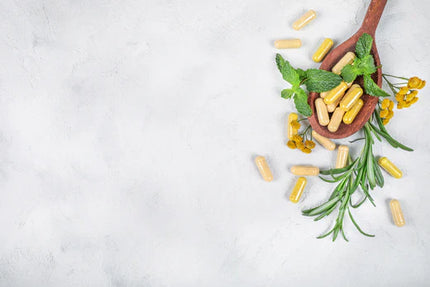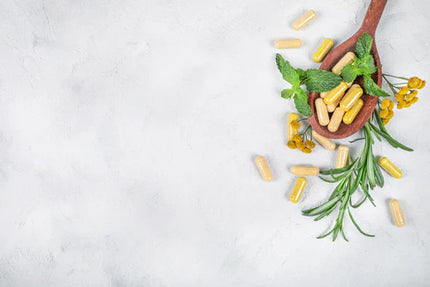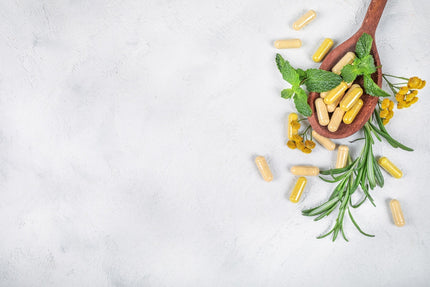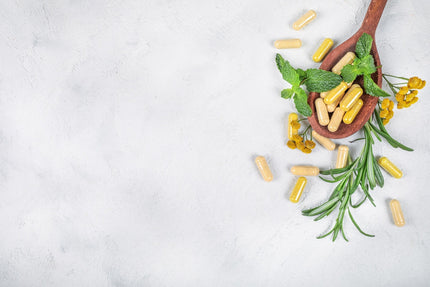Herbs, Nutrients and Probiotic Strains That May Assist
Lactobacillus rhamnosus (GR-1™)
Lactobacillus reuteri (RC-14™)
Ascorbic acid
Vitamin C
Colecalciferol
Vitamin D3
Glycyrrhiza glabra (GutGard ® liquorice), dry root
Actions
- Maintains healthy vaginal flora and urogenital pH
- Antimicrobial
- Soothes genitourinary inflammation
Clinical Applications
- Bacterial vaginosis and vulvovaginal candidiasis (‘thrush’)
- Urinary tract infections (UTIs)
Clinical Overview
The loss of protective lactobacilli bacteria within the vagina can have significant health impacts. Specifically, low levels of vaginal lactobacilli are linked to increased risk of developing urinary tract infections (UTIs), bacterial vaginosis (BV) and vulvovaginal candidiasis (VVC). 1 To support the management of these common infections, probiotic strains Lactobacillus rhamnosus (GR-1™) and Lactobacillus reuteri (RC-14™) can increase lactobacilli levels to restore vaginal ecology. 2–5 In addition, vitamin C and vitamin D may also help reduce UTI frequency, 6,7while, GutGard ® liquorice exerts antimicrobial actions against infectious organisms, 8, 9 and soothes mucosal inflammation. 10,11 Collectively, GR-1™, RC-14™, vitamins C and D with liquorice can support vaginal health (Figure 1).

Figure 1: Benefits of GR-1™, RC-14™, vitamins C and D with liquorice in supporting vaginal health to prevent opportunistic pathogens from developing into infections.
Background Information
Understanding healthy vaginal flora
The vaginal ecosystem features high levels of lactobacilli species that naturally help to protect the vagina from infection. Normally, vaginal lactobacilli produce an abundance of hydrogen peroxide and lactic acid to help maintain an acidic pH (i.e., between 3.8 to 4.5) within the vagina. This in turn helps to suppress the opportunistic growth of anaerobic bacteria. 12,13 Conversely, it follows that absent or inadequate levels of vaginal lactobacilli can disrupt healthy pH and therefore promote infections, such as UTIs, 14 BV and VVC. 1 To support vaginal health, probiotic strains L. rhamnosus (GR-1™) and L. reuteri (RC-14™) help to restore lactobacilli levels in women with a history of urogenital infections. 2–5 In addition, vitamin C and vitamin D can also help mitigate UTI symptoms. 6,7 and promote local urogenital immune function. Adding further clinical benefits, a deglycyrrhizinated[*] extract of liquorice root (GutGard ® liquorice) supports the healing of inflamed mucosa. 8,9 Therefore, this unique blend of probiotic strains, herbal medicines and nutrients can support better treatment outcomes in individuals who experience vaginal infections.
Actions
Maintains healthy vaginal flora and urogenital pH
Both GR-1™ and RC-14™ have been shown to colonise the vaginal tract following oral intake. 2,4,5,15,16 Clinically observed to restore vaginal lactobacilli,[†] 4 both GR-1™ and RC-14™ promote healthy vaginal pH to help control the growth of infectious organisms. 11,12 In effect, GR-1™ and RC-14™ supplementation may restore healthy levels of lactic acid and hydrogen peroxide levels 4 that effectively acidify the vaginal environment to inhibit the growth of pathogens associated with UTIs, BV and VVC infections. 15,17–20 Additionally, vitamin C may also promote a low pH in the urogenital tract. 21 As such, oral intake of GR-1™ and RC-14™ in combination with vitamin C can support a healthy vaginal environment.
Antimicrobial
Probiotic strains GR-1™ and RC-14™ help to maintain a low vaginal pH to suppress the growth of anaerobic bacteria and yeasts in the urogenital tract. 12,13 Subsequently, these strains can inhibit the growth of Escherichia coli 22 and Candida albicans. 23 Beyond these ingredients, vitamin C can also supress E. coli by blocking its uptake of sugars, therefore interrupting the metabolic processes that enable its survival. 24 Moreover, vitamin C can block biofilm formation and bacterial toxin production. 25–27 Further to this, liquorice exerts antimicrobial activity against both gram-positive and gram-negative bacteria and fungi, including E. coli, and C. albicans. 9 Adding to these effects, liquorice extracts have also been observed to inhibit the ability of C. albicans to switch from yeast to hyphae form and the formation of fungal biofilms. 28 Therefore, the unique blend of GR-1™ and RC-14™, vitamin C and liquorice can support resilience against pathogens associated with UTIs and thrush.
Soothes genitourinary inflammation
The vaginal wall acts as a protective barrier against pathogens to help maintain the local immune response. Research indicates that vitamin D promotes healthy mucosal function to prevent bacterial invasion and control inflammation within mucosa. 29 In addition, liquorice root is traditionally used for its demulcent actions within the genitourinary passage, 30 which may help to soothe irritation associated with mucosal infections.
Clinical Applications
Bacterial vaginosis (BV) and thrush
Numerous clinical trials endorse the efficacy of GR-1™ and RC-14™ to enhance vaginal microbiota. For example, in 48 women with normal vaginal flora (group 1) and 16 women with BV (group 2), one billion CFU/d of both strains for 60 days led to clear benefits. 2 Shown to protect vaginal lactobacilli levels (p<0.01), researchers found that 0% in the probiotic group developed BV over the trial duration, while 40% developed BV with placebo in group 1 (p<0.01). 2 Interestingly, in group 2 (i.e., women with BV; n = 16), GR-1™ and RC-14™ improved cultured swab samples in 59% of the treatment group versus 31% in the placebo group (p<0.01). 2
Additionally, in 42 women with a medical history of UTI, BV or yeast vaginitis, 1.6 billion CFU/d each of GR-1™ and RC-14™ improved vaginal microbiota composition. 3 In this trial, probiotic strains normalised Nugent scores[‡] after 28 days, representing a 1.8 fold increase in healthy microbial composition. 3 [§] Similarly, in 106 women diagnosed with BV, two billion CFU/d of each strain in combination with antibiotic treatment led to complete resolution of BV in 88% of patients versus 40% in patients who received placebo plus antibiotics (p<0.03). 5 Furthermore, in 544 women with an active BV, VVC and/or trichomoniasis infection, one billion CFU/d of GR-1™ and RC-14™ respectively over six weeks enhanced vaginal flora. 4 Namely, 61.2% of participants experienced improved microbial composition, which was sustained for up to six weeks (p<0.001). 4
Outside of this, vitamin D contributes further benefits for female genitourinary health. For example, evidence indicates that lower levels of serum vitamin D are associated with an increased risk of BV in women, 31 with supplementation of 2,000 IU/d shown to resolve asymptomatic BV. 32 Collectively this data endorses the role of therapeutic probiotics and nutrients to enhance patient outcomes.
Urinary tract infections (UTIs)
Research supports the benefits of 2 billion CFU/d of both GR-1™ and RC-14™ to lower UTI frequency in postmenopausal women. In this study, 252 women with recurrent UTIs received a cycling one-month script of either prophylactic antibiotics or GR-1™ and RC-14™. 33 Following the intervention periods, UTI frequency was reduced from 7.0 UTIs annually to 2.9 with antibiotics, and from 6.8 UTIs annually down to 3.3 in the probiotic group, respectively. While GR-1™ and RC-14™ did not outperform antibiotics, probiotic strains effectively limited pathogen growth and did not increase antibiotic resistance as was observed in the antibiotic group. 33
Interestingly, vitamin C may also help reduce the incidence of UTIs during the second and third trimester in pregnant women. 34 In one study with 110 women, 100 mg/d ascorbic acid in combination with 200 mg/d of iron and 5 mg/d folic acid over three months significantly reduced the number of urinary infections in patients by 16.4% (p<0.03). 27 Moreover, lower vitamin D levels have been observed in women who suffer UTI symptoms versus healthy women (p<0.01), supporting the value of ensuring adequate vitamin D status. 7
In conclusion, validated clinical data supports the therapeutic blend of GR-1™ and RC-14™, liquorice, vitamin C and vitamin D to enhance patient outcomes in female patients who experience UTIs, BV and VVC.
Table 1: Summary of clinical data that supports the use Probiotics Lactobacillus rhamnosus (GR-1™) and Lactobacillus reuteri (RC-14™) with liquorice for women’s urogenital health.
INTERVENTION |
DOSE |
OUTCOME |
Bacterial vaginosis (BV) and vulvovaginal candidiasis (VVC; ‘thrush’) | ||
|
Randomised, placebo-controlled, double-blind clinical trial (RCT) in 48 healthy women with normal vaginal flora and 16 asymptomatic women with bacterial vaginosis (BV). 2 |
1 billion CFU/d of RC-14™ and 1 billion CFU/d of GR-1™ orally for 60 days. |
|
|
Randomised, double-blind clinical study in 42 healthy women. 90.5% had previously experienced yeast vaginitis, urinary tract infections (UTIs) or BV or a combination during their lifetime. 3 |
Three treatment groups subject to 28 days intake of: 1. 800 million CFU/d of RC-14™ and 800 million CFU/d of GR-1™ daily; or, 2. 1.6 billion CFU/d of RC-14™ and 1.6 billion CFU/d of GR-1™ daily; or, 3. 6 billion CFU/d of RC-14™ and 6 billion CFU/d of GR-1™ daily; or, 4. 10 billion CFU/d of Lactobacillus rhamnosus GG |
|
RCT in 544 women diagnosed with BV, VVC, trichomoniasis or combination of these infections. 4 |
1 billion CFU/d of RC-14™ and 1 billion CFU/d of GR-1™ orally for six weeks |
|
RCT in 106 women diagnosed with BV. 5 |
2 billion CFU/d GR-1™ and 2 billion CFU/d RC-14™ following metronidazole treatment for 30 days |
|
Urinary tract infections (UTIs) | ||
|
Randomised, double-blind clinical trial in 152 female children with UTI resulting in pyelonephritis (i.e., kidney infection). 6 |
250 mg/d ascorbic acid (vitamin C) orally alongside parenteral antibiotics over 14 days. |
|
|
Randomised single-blind clinical trial in 110 pregnant women. 34 |
100 mg/d ascorbic acid in combination with 200 mg/d of iron and 5 mg/d folic acid over three months. |
|
Safety Information
Disclaimer: In the interest of supporting health Practitioners, all safety information provided at the time of publishing (Oct 2025) has been checked against authoritative sources. Please note that not all interactions have been listed.
For further information on specific interactions with health conditions and medications, refer to clinical support on 1800 777 648(AU), 0508 227 744(NZ) or via email, anz_clinicalsupport@metagenics.com, or via Live Chat www.metagenics.com.au, www.metagenics.co.nz
Prescribing Tips and Notes
- Antibiotics: Concomitant administration of antibiotics might decrease the effectiveness of Lactobacillus spp. However, concomitant use of probiotics reduces the likelihood of gastrointestinal and genitourinary side effects and co-administration is considered beneficial. Separate administration of antibiotics and Lactobacillus preparations by at least two hours.
Pregnancy
- Contraindicated: Unlikely to cause adverse effects if used for preconception and in the early weeks of pregnancy. However, once pregnancy is confirmed, discontinue.
Breastfeeding
- Limited/unavailable research: A review did not identify any concerns for use during breastfeeding; however, safety has not been conclusively established.
Contraindications
Nil
Cautions
- Antihypertensive medication: The mineralocorticoid effects of liquorice can increase blood pressure, and liquorice may alter the efficacy of the antihypertensive medication. Supplements that contain a low glycyrrhizin liquorice are less likely to have the same effect. However, it is recommended to still monitor patients for any changes.
- Chemotherapy/radiotherapy: It has generally been thought that antioxidants, such as vitamin C, may interfere with chemotherapy and/or radiotherapy by decreasing the efficacy of the treatment, although recent studies have found that antioxidants are safe to use in conjunction with these treatments. Check with a patient’s oncologist before recommending any formula containing antioxidants.
- Corticosteroids: Concurrent use of liquorice with oral corticosteroids may potentiate the effects of the corticosteroids. When used in combination, liquorice may increase potassium loss and the risk of potassium depletion. Use with caution in patients on acute or chronic corticosteroid therapy.
-
Digoxin: Use under medical supervision, avoid long-term use (e.g., more than two weeks) and avoid vitamin D doses above 2,000 IU (50 µg) daily.
- Hypercalcaemia induced by high doses of vitamin D (i.e., doses > 2,000 IU or 50 µg daily) can increase the risk of fatal cardiac arrhythmias with cardiac glycosides.
- Due to the potassium-decreasing activity of liquorice, the combination of liquorice with digoxin may increase the risk of cardiac/digitalis toxicity due to potassium loss.
- This cardiac glycoside drug is metabolised by cytochrome P450 3A4, and has a narrow therapeutic range.
-
Heart disease/valvular heart disease: When using this supplement, monitor patients for any changes and advise patients with valvular heart disease to discontinue use of probiotics prior to dental surgery or other invasive gastrointestinal procedures.
- The mineralocorticoid effects of liquorice can worsen congestive heart failure and fluid retention, as well as increase the risk of arrhythmias. Supplements that contain a low glycyrrhizin liquorice are less likely to have the same effect, however it is recommended to still monitor patients for any changes.
- Lactobacilli supplementation may increase the risk of endocarditis in patients with valvular heart disease. Cases of Lactobacillus endocarditis have been reported in patients with valvular heart disease who have taken Lactobacillus-containing probiotics before dental surgery, upper endoscopy, or colonoscopy.
- Hypertension: The mineralocorticoid effects of liquorice can increase blood pressure, and liquorice may alter the efficacy of the antihypertensive medication. This effect is attributed to the glycyrrhizin in liquorice. Supplements containing low glycyrrhizin liquorice are less likely to have the same effect; however, it is recommended to still monitor patients for any changes.
- Hypokalaemia: The mineralocorticoid effects of liquorice can decrease serum potassium levels and exacerbate hypokalaemia. Supplements containing low glycyrrhizin liquorice are less likely to have the same effect, however it is recommended to still monitor patients for any changes.
-
Oral contraceptive pill (OCP): Use cautiously in patients on this medication, monitor blood pressure and consider alternative contraceptive options whilst combining liquorice with OCPs.
- The mineralocorticoid effects of liquorice can increase effects from the OCP including hypokalaemia, fluid retention and elevated blood pressure. Supplements containing low glycyrrhizin liquorice are less likely to have the same effect, however it is recommended to still monitor patients for any changes.
- Liquorice may have phytoestrogenic properties and therefore may theoretically affect oestrogen therapies.
- Vitamin D doses above 2,000 IU (50 µg) daily may cause hypercalcaemia and should be avoided due to the risk of increased calcium accumulation.
- The mineralocorticoid effects of liquorice may worsen renal function. Supplements containing low glycyrrhizin liquorice are less likely to have the same effect; however, it is recommended to still monitor patients for any changes.
- The mineralocorticoid effects of liquorice can increase effects from the OCP including hypokalaemia, fluid retention and elevated blood pressure. Supplements containing low glycyrrhizin liquorice are less likely to have the same effect, however it is recommended to still monitor patients for any changes.
Footnotes
[*] Glycyrrhizinic and glycyrrhetinic acid within liquorice can aggravate hypertension, water retention and hypokalaemia due to its mineral corticoid-like activity. The removal of these compounds provides anti-inflammatory benefits without impacting blood pressure and fluid balance.
[†] High counts of vaginal lactobacilli are considered as a swab containing>105 colony forming units (CFU) per millilitre.
[‡] The Nugent Score is a gram stain scoring system for vaginal swabs to diagnose bacterial vaginosis based on culture characteristics.
[§] Of the total sample (n = 42), probiotics improved vaginal flora Nugent scores to healthy levels in 38/42 women post-intervention, a 1.8x increase from 21/42 women at baseline.
[**]* The Nugent Score is a gram stain scoring system for vaginal swabs to diagnose bacterial vaginosis based on culture characteristics.
References
1. Cohen K, Powderly W, Opal S. Infectious Diseases. 4th ed. Elsevier; 2016.
2. Reid G, Charbonneau D, Erb J, et al. Oral use of Lactobacillus rhamnosus GR‐1 and L. fermentum RC‐14 significantly alters vaginal flora: randomized, placebo‐controlled trial in 64 healthy women. Fems Immunol Medical Microbiol. 2003;35(2):131-134. doi:10.1016/s0928-8244(02)00465-0
3. Reid G, Beuerman D, Heinemann C, Bruce AW. Probiotic Lactobacillus dose required to restore and maintain a normal vaginal flora. Fems Immunol Medical Microbiol. 2001;32(1):37-41. doi:10.1111/j.1574-695x.2001.tb00531.x
4. Vujic G, Knez AJ, Stefanovic VD, Vrbanovic VK. Efficacy of orally applied probiotic capsules for bacterial vaginosis and other vaginal infections: a double-blind, randomized, placebo-controlled study. Eur J Obstet Gyn R B. 2013;168(1):75-79. doi:10.1016/j.ejogrb.2012.12.031
5. Anukam K, Osazuwa E, Ahonkhai I, et al. Augmentation of antimicrobial metronidazole therapy of bacterial vaginosis with oral probiotic Lactobacillus rhamnosus GR-1 and Lactobacillus reuteri RC-14: randomized, double-blind, placebo controlled trial. Microbes Infect. 2006;8(6):1450-1454. doi:10.1016/j.micinf.2006.01.003
6. Yousefichaijan P, Goudarzi AA, Rezagholizamenjany M, et al. Efficacy of ascorbic acid supplementation in relief of symptoms due to febrile upper urinary tract infection in children, a clinical trial and hospital based study. Archives Pediatric Infect Dis. 2018;In Press(In Press). doi:10.5812/pedinfect.57071
7. Wang L, Yang R, Yuan B, Liu Y, Liu C. The antiviral and antimicrobial activities of licorice, a widely-used Chinese herb. Acta Pharm Sinica B. 2015;5(4):310-315. doi:10.1016/j.apsb.2015.05.005
8. Tewari SN, Wilson AK. Deglycyrrhizinated liquorice in duodenal ulcer. Pract. 1973;210(260):820-823.
9. Mukherjee M, Bhaskaran N, Srinath R, et al. Anti-ulcer and antioxidant activity of GutGard. Indian J Exp Biol. 2010;48(3):269-274.
10. Korenek P, Britt R, Hawkins C. Differentiation of the vaginoses- bacterial vaginosis, lactobacillosis, and cytolytic vaginosis. Internet J Adv Nurs Pract. 2003;6(1). doi:10.5580/25f5
11. Donders GGG, Bellen G, Grinceviciene S, Ruban K, Vieira-Baptista P. Aerobic vaginitis: no longer a stranger. Res Microbiol. 2017;168(9-10):845-858. doi:10.1016/j.resmic.2017.04.004
12. Harmanli O, GY C, Nyirjesy P, Chatwani A, JP G. Urinary tract infections in women with bacterial vaginosis. Obstetrics Gynecol. 2000;95(5):710-712. doi:10.1097/00006250-200005000-00015
13. Liu L, Xie K, Yin M, et al. Lower serum levels of vitamin D in adults with urinary tract infection. Infection. 2022;50(3):739-746. doi:10.1007/s15010-021-01750-2
14. Strohle A, Wolters M, Hahn A. Micronutrients at the Interface Between Inflammation and Infection Ascorbic Acid and Calciferol. Part 1: General Overview with a Focus on Ascorbic Acid. Inflamm Allergy - Drug Targets. 2011;10(1):54-63. doi:10.2174/187152811794352105
15. Homayouni A, Bastani P, Ziyadi S, et al. Effects of probiotics on the recurrence of bacterial vaginosis. J Low Genit Tract Di. 2014;18(1):79-86. doi:10.1097/lgt.0b013e31829156ec
16. Reid G, Bruce AW. Urogenital infections in women: can probiotics help? Postgrad Med J. 2003;79(934):428. doi:10.1136/pmj.79.934.428
17. Younes JA, Lievens E, Hummelen R, Westen R van der, Reid G, Petrova MI. Women and their microbes: the unexpected friendship. Trends Microbiol. 2018;26(1):16-32. doi:10.1016/j.tim.2017.07.008
18. Jeavons HS. Prevention and treatment of vulvovaginal candidiasis using exogenous lactobacillus. J Obstetric Gynecol Neonatal Nurs. 2003;32(3):287-296. doi:10.1177/0884217503253439
19. Hickey RJ, Zhou X, Pierson JD, Ravel J, Forney LJ. Understanding vaginal microbiome complexity from an ecological perspective. Transl Res. 2012;160(4):267-282. doi:10.1016/j.trsl.2012.02.008
20. Gil NF, Martinez RCR, Gomes BC, Nomizo A, Martinis ECPD. Vaginal lactobacilli as potential probiotics against Candida SPP. Braz J Microbiol. 2010;41(1):6-14. doi:10.1590/s1517-83822010000100002
21. Zodzika J, Rezeberga D, Donders G, et al. Impact of vaginal ascorbic acid on abnormal vaginal microflora. Arch Gynecol Obstet. 2013;288(5):1039-1044. doi:10.1007/s00404-013-2876-y
22. Cadieux PA, Burton J, Devillard E, Reid G. Lactobacillus by-products inhibit the growth and virulence of uropathogenic Escherichia coli. J Physiology Pharmacol Official J Pol Physiological Soc. 2009;60 Suppl 6:13-18.
23. Köhler GA, Assefa S, Reid G. Probiotic Interference of Lactobacillus rhamnosus GR-1 and Lactobacillus reuteri RC-14 with the Opportunistic Fungal Pathogen Candida albicans. Infect Dis Obstetrics Gynecol. 2012;2012:636474. doi:10.1155/2012/636474
24. Afzal S, M A, A B, S A, AD R. Efficacy of Anti-Microbial Agents with Ascorbic Acid in Catheter Associated Urinary Tract Infection. J Infect Dis Prev Medicine. 2017;5(3):1-6. doi:10.4172/2329-8731.1000166
25. El-Gebaly E. Effect of Levofloxacin and Vitamin C on Bacterial Adherence and Preformed Biofilm on Urethral Catheter Surfaces. J Microb Biochem Technology. 2012;04(06). doi:10.4172/1948-5948.1000083
26. Novak J, Fratamico P. Evaluation of ascorbic acid as a quorum‐sensing analogue to control growth, sporulation, and enterotoxin production in Clostridium perfringens. J Food Sci. 2004;69(3):FMS72-FMS78. doi:10.1111/j.1365-2621.2004.tb13374.x
27. El‐Mowafy SA, Shaaban MI, Galil KHAE. Sodium ascorbate as a quorum sensing inhibitor of Pseudomonas aeruginosa. J Appl Microbiol. 2014;117(5):1388-1399. doi:10.1111/jam.12631
28. Sharma P, Tyagi A, Bhansali P, et al. Saponins: Extraction, bio-medicinal properties and way forward to anti-viral representatives. Food Chem Toxicol. 2021;150:112075. doi:10.1016/j.fct.2021.112075
29. Kapoor L. Handbook of Ayurvedic Medicinal Plants. CRC Press; 1990.
30. Felter H, Lloyd J. King’s American Dispensatory. 18th ed. Nabu Press; 1898.
31. Mojtahedi SF, Mohammadzadeh A, Mohammadzadeh F, Shahri JJ, Bahri N. Association between bacterial vaginosis and 25-Hydroxy vitamin D: a case-control study. Bmc Infect Dis. 2023;23(1):208. doi:10.1186/s12879-023-08120-3
32. Taheri M, Baheiraei A, Foroushani AR, Nikmanesh B, Modarres M. Treatment of vitamin D deficiency is an effective method in the elimination of asymptomatic bacterial vaginosis: A placebo-controlled randomized clinical trial. Indian J Medical Res. 2015;141(6):799-806. doi:10.4103/0971-5916.160707
33. Beerepoot MAJ, Riet G ter, Nys S, et al. Lactobacilli vs antibiotics to prevent urinary tract infections: a randomized, double-blind, noninferiority trial in postmenopausal women. Arch Intern Med. 2012;172(9):704-712. doi:10.1001/archinternmed.2012.777
34. Ochoa-Brust G, AR AF, Villanueva-Ruiz G, Velasco R, Trujillo-Hernández B, Vásquez C. Daily intake of 100 mg ascorbic acid as urinary tract infection prophylactic agent during pregnancy. Acta Obstet Gyn Scan. 2007;86(7):783-787. doi:10.1080/00016340701273189




